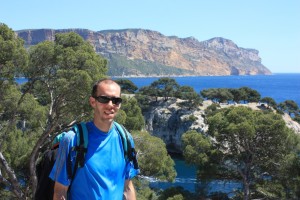 Dr. Damien Quemener gained his Pd.D in 2005 in the “Laboratoire de Chimie des Polymères Organiques” at Bordeaux University (France), and was a postdoctoral fellow at the University of New South Wales (Center for Advanced Macromolecular Design) in Sydney, Australia until 2006. He joined Montpellier University in 2007 as an Associate Professor, working at the “Institut Europeen des Membranes” in Montpellier, France. He works at the interface between chemistry and physical chemistry of polymers and membranes with the goal of preparing new autonomous and dynamic porous materials.
Dr. Damien Quemener gained his Pd.D in 2005 in the “Laboratoire de Chimie des Polymères Organiques” at Bordeaux University (France), and was a postdoctoral fellow at the University of New South Wales (Center for Advanced Macromolecular Design) in Sydney, Australia until 2006. He joined Montpellier University in 2007 as an Associate Professor, working at the “Institut Europeen des Membranes” in Montpellier, France. He works at the interface between chemistry and physical chemistry of polymers and membranes with the goal of preparing new autonomous and dynamic porous materials.
What was your inspiration in becoming a chemist?
When I was at junior high school, I gained work experience in a medical laboratory, where I undertook simple and automatic analyses. I was fascinated by the fact that a simple colour change could give you very important results in the quest of a medical diagnostic. But right after I was also frustrated that I didn’t understand the theory beyond that so I decided to study chemistry not to change the world but to simply have a better understanding of it.
What was the motivation to write your Polymer Chemistry article?
Filtration membranes are now everywhere and are recognised as a key technology, for example in water purification. Classical membranes are designed to be highly stable towards mechanical and chemical stresses. We decided to take the opposite strategy in saying that a membrane should be unstable but controlled, in order to make it possible to adapt to any environmental changes. Therefore we have prepared a membrane from block copolymer micelles responsive to water pressure, pH or UV radiation.
Why did you choose Polymer Chemistry to publish your work?
Well, Polymer Chemistry is quite a new and very dynamic journal having a strong impact in the polymer community, and also because it’s a very quick way to publish hot results since the time to publication is short.
In which upcoming conferences may our readers meet you?
This year, I might attend Euromembrane 2015 on the 6-10. September 2015 in Germany but my plans are not yet finalised.
How do you spend your spare time?
Apart from my work, I love to spend my free time with my family since my two boys keep me connected to the day to day reality. I’m also a runner and I’m trying to run two marathons every year, my most recent one was Paris in April.
Which profession would you choose if you were not a scientist?
I would definitely be an architect and build modern style houses since I love to see how something drawn on a piece of paper can be transferred to life-size scale. That’s a common occurrence in the role of a researcher to.

Stimuli responsive nanostructured porous network from triblock copolymer self-assemblies
Zineb Mouline, Mona Semsarilar, Andre Deratani and Damien Quemener

An ABA triblock amphiphilic copolymer is synthesized using RAFT chemistry. The self-assembled micelles of this copolymer are then used to prepare nano-organized porous films that could be used as filtration membranes. In this work a novel strategy is developed to build the nanostructures and perform their self-assembly using reversible and non-covalent interactions to create free volume between the micelles, thus giving tuneable porosity to the film. The self-assembly of poly(styrene)-b-poly(phenylboronic acid)-b-poly(styrene) block copolymer, occurs at high concentration through solvent evaporation, which induces a progressive decrease of the inter-micellar distance, and results in the formation of an in situ network of micelles and the final porous film. Subsequent permeability tests were conducted under different stimuli (pH and UV), generating cross-linking and chemical exchange reactions, to ensure the best balance between permeability and mechanical strength. This work highlights an original strategy for pore size control, and provides new insights towards the design of stimuli-responsive materials.
Cyrille Boyer is a guest web-writer for Polymer Chemistry. He is currently an Associate Professor and an ARC-Future Fellow in the School of Chemical Engineering, University of New South Wales (Australia) and Deputy Director of the Australian Centre for NanoMedicine.










